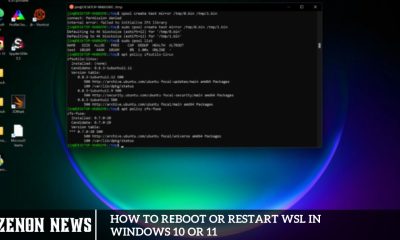News
Instant Expertise-The Impact of On Demand Developers in Tech

Evolving tech industry landscape, the need for readily available developers has reached unprecedented levels. Corporations frequently encounter hurdles in sourcing suitable talent, coordinating project schedules, and sustaining competitiveness in a constantly changing environment. Consequently, the emergence of the on-demand economy has proven transformative, providing enterprises with immediate access to specialized skills precisely when and where they are required. In this discourse, we shall delve into the notion of on-demand developers, examining their benefits, influence on project advancement, obstacles encountered, and forthcoming trends.
In the dynamic digital landscape, businesses must quickly adjust to remain competitive. One pivotal tactic for maintaining an edge is utilizing on-demand developers. These versatile professionals bring a wealth of expertise and experience, simplifying the management of intricate business projects. This article delves into the advantages of on-demand developers and their potential to revolutionize tech talent sourcing for companies.
Exploring the On-Demand Economy’s Role in the Tech Sector
The on-demand economy has revolutionized multiple sectors: transportation, hospitality, healthcare, and retail. Within the tech industry, this phenomenon has spawned platforms and services, facilitating the connection between businesses and proficient professionals on a project-oriented basis. This transition underscores the increasing inclination towards flexibility, efficiency, and scalability in the procurement and execution of work.
The Evolution of Tech Talent Acquisition
In today’s rapidly evolving tech landscape, the way companies acquire talent has significantly transformed. Traditional talent acquisition methods, such as lengthy recruitment processes and reliance on in-house teams, are giving way to more agile and dynamic approaches. As businesses strive to stay competitive in an increasingly digital world, the evolution of tech talent acquisition is reshaping the industry landscape. Let’s explore how this evolution unfolds and its implications for businesses and professionals.
Understanding On-Demand Developer Services
Defining On-Demand Developers: Characteristics and Traits
On-demand developers are proficient experts who offer their specialized skills on a flexible, project-specific basis. They excel in various domains, such as software development, web design, and mobile app development. Unlike conventional hiring approaches that recruit full-time employees, on-demand developers allow businesses to adjust their workforce to project demands.
Distinguishing On-Demand Developers from Traditional Hiring Models
Traditional hiring models typically entail extensive recruitment procedures, prolonged onboarding processes, and fixed-term employment contracts. In contrast, on-demand developers provide businesses with swift access to talent without overhead costs and administrative complexities associated with full-time positions. This adaptable staffing approach empowers companies to respond more efficiently to evolving project needs and market dynamics.
Sloboda Studio, boasting over 14 years of industry expertise and a remarkable portfolio comprising over 200 successful projects, stands as a trailblazer in the on-demand developer arena. As one of the pioneering Ruby on Rails companies in Europe, Sloboda Studio epitomizes the strategic utilization of on-demand developers to foster innovation and drive project triumph.
Benefits of On-Demand Developers
Flexibility: On-demand developers offer businesses the flexibility to scale their workforce up or down according to project requirements, allowing for efficient resource allocation.
Cost-Effectiveness: By engaging on-demand developers, companies can avoid the overhead costs associated with full-time employment, such as salaries, benefits, and office space, leading to potential cost savings.
Access to Specialized Skills: On-demand developers often possess niche expertise in specific technologies or domains, providing businesses with access to specialized skills that may not be available in-house.
Quick Deployment: On-demand developers can be onboarded swiftly, enabling businesses to kickstart projects without the delays typically associated with traditional hiring processes.
Focus on Core Competencies: Leveraging on-demand developers allows companies to focus on their core competencies while delegating specialized tasks to external experts, enhancing overall efficiency and productivity.
Adaptability: With on-demand developers, businesses can quickly adapt to changing project scopes, timelines, and priorities, ensuring greater agility in a dynamic market environment.
Impact on Project Development and Management
Accelerated Timelines: Engaging on-demand developers can expedite project timelines by providing immediate access to skilled resources, enabling faster development and deployment cycles.
Enhanced Resource Utilization: On-demand developers allow businesses to allocate resources more efficiently, ensuring that projects are adequately staffed without the burden of maintaining a full-time workforce.
Increased Innovation: Access to on-demand developers with diverse skill sets can foster innovation within project teams, bringing fresh perspectives and novel approaches to problem-solving.
Improved Risk Management: By leveraging on-demand developers, companies can mitigate risks associated with talent shortages, skill gaps, and changing project requirements, enhancing project stability and success rates.
Streamlined Budgeting: On-demand developer engagements often follow a pay-as-you-go model, allowing businesses to better manage project budgets by only paying for the resources they need when they need them.
Heightened Focus on Deliverables: With on-demand developers handling specific tasks or projects, internal teams can concentrate on core project objectives and strategic initiatives, improving project outcomes and client satisfaction.
Challenges and Considerations
Communication and Collaboration: Effective communication and collaboration between on-demand developers and internal teams can be challenging, especially when working remotely or across different time zones.
Integration with Existing Processes: Smoothly integrating on-demand developers into existing project management processes and workflows may require adjustments to accommodate external contributors.
Cultural Fit: It can be difficult to maintain alignment with the company culture and values when working with on-demand developers who are not directly employed by the organization.
Quality Assurance: Ensuring the quality and consistency of work delivered by on-demand developers may require additional oversight and quality assurance processes to maintain project standards.
Security and Confidentiality: Managing data security and confidentiality risks associated with granting access to sensitive information to external developers is critical in on-demand engagements.
Dependency on External Resources: Relying heavily on on-demand developers for critical project tasks can pose risks in terms of dependency and availability, especially if crucial contributors become unavailable or their services are terminated abruptly.
Future Trends and Predictions
Increased Adoption of Remote Work: The trend towards remote work is expected to continue, leading to a rise in the demand for on-demand developers who can work from anywhere in the world.
Growth of Platform-Based Solutions: Platform-based solutions connecting businesses with on-demand developers are anticipated to increase, offering streamlined access to talent and facilitating project management.
Specialization in Emerging Technologies: With rapid advancements in technologies such as artificial intelligence, blockchain, and augmented reality, there will be a growing demand for on-demand developers with expertise in these emerging domains.
Rise of Hybrid Work Models: Hybrid work models combining in-house teams with on-demand developers are likely to become more prevalent, offering the benefits of both flexibility and stability.
Emphasis on Soft Skills: As collaboration and communication become increasingly important in distributed work environments, the value of on-demand developers possessing strong interpersonal and teamwork skills is expected to grow.
Integration of AI and Automation: Integrating artificial intelligence and automation tools into on-demand development platforms will streamline processes, improve efficiency, and enhance the developer experience.
Faster Time to Market
On-demand developers inject speed and agility into development projects. With their specialized expertise, they swiftly adjust to new assignments, expediting timelines and accelerating product launches. They promptly deliver high-quality solutions by concentrating solely on specific projects and being unburdened by administrative tasks. This rapid pace can profoundly influence success in today’s fast-paced business environment.
Transferring Knowledge and Ensuring Continuity
One of the primary advantages of on-demand developers is their ability to facilitate knowledge transfer. This process is optimized, ensuring continuity across projects. Platforms like Hokantan streamline and automate knowledge transfer, centralizing essential project and company information for subsequent developers. This eradicates knowledge gaps, enabling companies to build upon past work seamlessly. A meticulously documented project history allows development to progress smoothly, even when developers are swapped out.
Flexible Development Methodology
The emergence of agile development methodologies has revolutionized project management strategies within companies. On-demand developers, adept in agile practices, empower businesses to adopt a flexible and iterative approach to development. This methodology fosters collaboration, enhances adaptability, and shortens feedback loops, resulting in efficient outcomes that align closely with customer requirements. Leveraging on-demand developers enables organizations to embrace agile principles, promoting ongoing enhancement in their development procedures.
Established Enterprises Favor On-Demand Developers
In today’s business landscape, many successful companies embrace a leaner in-house workforce model, opting instead for a diverse pool of skilled on-demand developers who operate remotely and virtually. The trend of hiring on-demand developers is gaining momentum as companies recognize the value of accessing specialized skills and expertise that may need to be more readily available within their internal teams.
Moreover, it’s essential to acknowledge that different cities boast unique talent pools, and numerous skilled on-demand developers may prefer to stay in the same place for traditional employment. For instance, IT and automation professionals located in major IT hubs may opt for remote work opportunities rather than relocating. Companies seeking to tap into specialized talent across different geographic locations increasingly favor remote work arrangements. This growing appreciation for remote work is fueling more companies’ adoption of this approach.
Expansion of Online Marketplaces and Emergence of Specialized Platforms
The proliferation of online marketplaces represents a significant trend in the on-demand developer sector. These platforms serve as hubs where customers can connect with on-demand developers for project collaboration. By leveraging online marketplaces, clients gain access to a broad pool of potential developers while simplifying the process of identifying and engaging qualified professionals.
The landscape of online marketplaces catering to on-demand developers is poised for substantial growth. These platforms vary in size, service categories, and fee structures, offering transparency that fosters trust and facilitates efficient collaboration between clients and developers.
In addition to general-purpose marketplaces, niche platforms targeting specific industries or types of work are emerging. These niche marketplaces cater to specialized roles such as data analysts, mobile app developers, and web developers, providing tailored opportunities for developers with expertise in niche fields.
The expansion of online marketplaces bodes well for the on-demand developer industry, streamlining the connection, collaboration, and completion of projects between clients and developers. As the demand for on-demand developer services continues to surge, the emergence of additional online marketplaces is inevitable, catering to the needs of both clients and developers alike.
The On-Demand Workforce: A Career Lifestyle, Not a Career Trajectory
We foresee a significant evolution from viewing the on-demand workforce as a distinct career path to it becoming a viable option within any career trajectory. Currently, professionals often consider on-demand work an extension of their primary profession. For example, web developers may more readily embrace gig work as a means of career progression than those in legal professions. However, we anticipate this distinction fading over time.
Professionals will increasingly prioritize what they want to do and how they want to work. They’ll be flexible in choosing their career path, whether in-house employees or on-demand contractors. Ultimately, we anticipate greater adaptability for both employees and businesses, with a growing demand for the freedom to explore diverse job arrangements in the future.
Traits of On-Demand Applications
On-demand applications stand out from regular mobile apps due to their distinct characteristics:
Instant Services: These apps prioritize providing services or products almost instantly. Users expect prompt responses and timely deliveries, whether it’s a ride or a meal.
Geo-tracking: A pivotal feature, geo-tracking enables users to monitor their service in real-time, whether it’s a delivery rider or a cab. This enhances transparency and fosters trust between users and service providers.
Payment Integration: On-demand apps feature integrated payment systems, allowing users to conveniently pay for services or products within the app. This seamless transaction process enhances user experience and ensures efficient operations.
Dynamic Pricing: Many on-demand apps employ dynamic pricing models, where prices fluctuate based on demand, time, or other factors. This enables effective revenue optimization and demand management.
Feedback Mechanism: User feedback is integral to on-demand apps. These apps often incorporate built-in systems for ratings and reviews, enabling users to share their experiences and service providers to continuously improve their offerings.
Leveraging Flexibility for Scalability
In the dynamic realm of technology, the ability to scale quickly and efficiently is paramount for businesses striving to meet evolving demands and seize emerging opportunities. One of the key strategies for achieving this scalability is leveraging flexibility in workforce management. Companies can adapt their resources to match fluctuating project requirements and market conditions by tapping into a diverse pool of on-demand talent. This flexibility empowers organizations to scale their operations seamlessly, whether ramping up during peak seasons or adjusting resources in response to changing business needs. By embracing flexibility, businesses can position themselves to thrive in an ever-changing tech landscape.
Mitigating Resource Constraints
In the fast-paced world of technology, resource constraints can often impede the progress of projects and hinder innovation. However, businesses are increasingly turning to on-demand developers as a solution to mitigate these constraints. By tapping into a global pool of skilled professionals, companies can access the expertise they need without being limited by geographical boundaries or internal capacity constraints. This approach allows organizations to overcome resource shortages and gives them the agility to scale their teams up or down as required by project demands. As a result, leveraging on-demand developers becomes a strategic advantage in navigating resource challenges and driving continuous growth in the tech industry.
Frequently Asked Questions
What are on-demand developers?
On-demand developers are skilled professionals who offer their services flexibly, as needed. They are typically hired for short-term projects, specific tasks, or to augment an existing team.
How do on-demand developers differ from full-time employees?
On-demand developers work freelance or contract, meaning they are not permanent company employees. They provide their expertise for a defined period or project, offering businesses flexibility and scalability without the commitment of hiring full-time staff.
What roles do on-demand developers play in the tech industry?
On-demand developers can fill various roles within the tech industry, including software development, web development, mobile app development, UX/UI design, QA testing, and more. They bring specialized skills and expertise to tackle specific tasks or projects efficiently.
What are the benefits of hiring on-demand developers?
Hiring on-demand developers offers several benefits, including access to specialized skills, flexibility in staffing, cost-effectiveness, faster project turnaround times, and the ability to scale resources according to project needs. Additionally, it allows businesses to tap into a global talent pool without geographical constraints.
How do businesses find and hire on-demand developers?
Businesses can find on-demand developers through various platforms and marketplaces specialized in freelance or contract work, such as Upwork, Freelancer, Toptal, and many others. Additionally, networking, referrals, and professional associations are valuable resources for connecting with skilled on-demand developers.
What challenges do businesses face when working with on-demand developers?
Some challenges of working with on-demand developers include communication barriers due to geographical differences, ensuring the quality of work, managing project timelines effectively, and maintaining confidentiality and security standards. However, these challenges can be mitigated with proper planning, communication tools, and clear expectations.
How do on-demand developers contribute to innovation in the tech industry?
On-demand developers bring fresh perspectives, diverse skill sets, and specialized knowledge to projects, fostering innovation within the tech industry. Their ability to adapt quickly to new technologies and approaches enables businesses to stay competitive and push the boundaries of what’s possible in software development.
Conclusion
The rise of on-demand developers has significantly impacted the tech industry, providing businesses with instant access to specialized expertise, flexibility in staffing, and accelerated innovation. By leveraging the skills of on-demand developers, companies can efficiently tackle short-term projects, fill skill gaps, and stay competitive in a rapidly evolving landscape. While challenges such as communication barriers and project management complexities exist, proactive measures can be taken to mitigate these issues and maximize the benefits of on-demand developer partnerships. As technology advances and the demand for specialized talent grows, the role of on-demand developers will likely become even more integral to the success of businesses in the tech sector and beyond.
News
Binary Option Is It Safe? Answer

Introduction
Binary options are a financial instrument that allows traders to bet on the direction of a certain asset’s price movement for a fixed amount of time. Despite their attractiveness because of their simplicity and the possibility of making quick money, they involve high risks.
What are Binary Options?
Binary options (or “digital options”) offer two possible outcomes: the trader either makes a fixed profit or loses his bet. This allows you to know in advance the amount of possible profit and loss. Among the advantages of binary options:
- Trading binary options does not require in-depth knowledge of financial markets or complex strategies. You only need to predict whether the price will be higher or lower than the current price.
- The opportunity to make money in the shortest possible time.
- Binary options often have expiration dates of a few minutes.
- The trader knows how much he or she can lose or make even before making a trade. This helps to manage risk more effectively.
- Many options brokers are ready to offer convenient and functional trading terminals, such as the author’s terminal Pocket Option – a reliable broker that has earned the trust of traders.
Binary Options Risks
Binary options are considered a high-risk instrument because price fluctuations on short time intervals can be unpredictable. In some countries, binary options are almost unregulated, which creates a favorable environment for fraudsters and unscrupulous brokers. Without proper analysis and strategy, trading binary options can become a game of chance, where the outcome of trades depends more on luck than on the trader’s skill.
Scams and Unscrupulous Brokers
Fraud in the binary options industry is common. Often scammers create fake platforms that do not pay out winnings or manipulate prices. Here are a few signs to look out for:
- Hidden terms of bonuses and promotions.
- Broker may delay or refuse to withdraw funds.
- Dishonest brokers may change asset prices in their favor.
- Too many negative reviews about the broker on the web.
Precautions
- Choosing a reliable broker
Check for licensing and regulation. Reliable regulators: FCA (UK), CySEC (Cyprus), ASIC (Australia), etc. Read reviews from real users and check broker ratings on independent platforms.
One of the top and reliable brokers today is Pocket Option, on whose website you can study its license, see its terminal, trading conditions, withdrawal conditions and contact support. All this shows that such a broker can be trusted.
- Training and practice
Take courses on binary options trading. Use the broker’s demo account to practice without the risk of losses.
- Strategy development
Study different trading strategies and choose the one that suits you. Apply technical and fundamental analysis to make informed decisions.
- Risk Control
Determine how much capital you are willing to risk in each trade. Use risk management strategies, such as setting stop losses and take profits.
- Explore the market
Learn the basics of how financial markets work and the different types of assets you can work with. Study the macroeconomic factors that can affect asset prices.
- Be careful with bonuses
Some brokers offer deposit bonuses, but they may come with complicated withdrawal terms. Therefore, read the terms and conditions of bonuses and promotions carefully.
- Keep an eye on the news
Economic events and news can have a significant impact on asset prices. Use economic calendars and keep an eye on major events that can affect your trading.

Conclusion
Binary options offer the opportunity to make quick money, but they also come with high risks. Success in binary options trading requires education, experience and discipline. Choose your broker carefully, continually educate yourself and develop strategies to minimize risk and increase your chances of success. Always remember that investing in financial instruments, including binary options, can lead to losses, so invest responsibly and only invest what you are willing to lose.
News
White Hair and Natural Prevention Methods – Wellhealthorganic.com

Have you started noticing white strands among your once-pigmented hair? You might be wondering what’s causing this change and how to prevent it. Don’t worry; you’re in the right place! Welcome to WellHealthOrganic’s guide on understanding the causes of white hair and exploring natural prevention methods.
Imagine this scenario: you’re preparing for a special event, and a silver strand catches your eye as you glance in the mirror. While some embrace the wisdom that comes with gray hair, others may wish to preserve their youthful appearance a little longer. Regardless of your perspective, we’re here to explore the science behind this change and provide natural, practical strategies to maintain your hair’s vitality.
So, find a comfortable spot, brew a soothing cup of herbal tea, and join us on a journey to uncover the secrets of white hair and discover ways to nurture your locks with care. Your hair deserves the best, and we’re here to guide you every step of the way.
White Hair: WellHealthOrganic.com’s Guide to Causes and Natural Prevention
Imagine having a trusted resource that serves as your guide to navigating the complexities of white hair. That’s precisely what “WellHealthOrganic.com’s Guide to White Hair Causes and Natural Prevention” offers!
This website is your go-to source for understanding why your hair might be turning white and discovering easy, natural methods to prevent it. Think of it as a knowledgeable friend who shares insights on why hair changes color and how to maintain its natural hue without relying on harsh treatments.
Covering everything from the science behind white hair to practical tips for preserving your hair’s youthful appearance, this resource has it all. If you’re curious about those emerging white strands and eager to explore natural remedies, WellHealthOrganic.com is your guide.
The Importance of WellHealthOrganic.com’s Guide to White Hair Causes and Natural Prevention
Understanding why hair turns white and discovering natural prevention methods is essential for maintaining vibrant, healthy locks. Here’s why this knowledge matters:
Preserve Your Youthful Appearance:
By understanding the causes of white hair, you can take proactive measures to extend your youthful appearance. Natural prevention techniques help retain your hair’s original color, keeping you looking and feeling youthful for longer.
Empowerment Through Knowledge:
Knowledge empowers you to make informed decisions about hair care. WellHealthOrganic.com provides the information you need to manage your hair’s health confidently.
Avoid Harmful Chemicals:
Many commercial hair products contain harsh chemicals that can damage your hair. Natural prevention methods help you avoid these substances, protecting your hair and scalp.
Holistic Well-Being:
Hair care is not just about aesthetics; it’s about overall well-being. Natural methods support your health by promoting a balanced lifestyle and enhancing your overall wellness.
Boost Self-Confidence:
Maintaining your natural hair color can significantly enhance your self-esteem. Preventing premature graying through natural methods can boost your confidence and positively impact your self-image.
Sustainable Hair Care:
Natural remedies are often more eco-friendly than conventional products. By choosing natural methods, you reduce your environmental footprint and support sustainable practices.
Long-Term Hair Health:
Natural prevention focuses on nurturing your hair from within. A holistic approach promotes long-term health and vibrancy, ensuring strong and healthy hair for years.
Comprehensive Step-by-Step Guide to Natural Hair Care | WellHealthOrganic.com
Understanding White Hair Causes:
Discover the factors contributing to white hair, such as genetics, aging, and environmental influences. Understand the role of melanin, the pigment responsible for hair color, and how its gradual decline leads to the appearance of white hair.
Assessing Genetic Factors:
Explore how family history and genetics influence the onset and extent of white hair. Consider genetic insights or consult healthcare professionals to assess your risk factors.
Exploring Environmental Influences:
Identify how pollutants, UV rays, and chemical treatments can accelerate graying. Take proactive steps to minimize exposure to these harmful elements and protect your hair from damage.

Embracing Natural Prevention Methods:
Explore natural methods to prevent white hair without relying on harsh chemicals. Embrace a holistic approach with proper nutrition, stress management, and natural hair care routines.
Nourishing Your Body:
Understand how a balanced diet supports healthy hair and can help delay graying. Incorporate antioxidant-rich foods and essential nutrients to maintain hair pigmentation and overall vitality.
Managing Stress:
Recognize how stress affects hair health and contributes to premature graying. Practice relaxation techniques like meditation, yoga, and deep breathing to manage stress and support healthy hair.
Adopting Natural Hair Care Routines:
Implement gentle hair care practices, including regular washing and conditioning. Use natural products free from harsh chemicals to preserve your hair’s color and health.
Incorporating Herbal Remedies:
Explore herbal treatments like henna, amla, and sage to enhance your hair color. Experiment with homemade masks and natural remedies to strengthen and nourish your hair.
Seeking Professional Advice:
Consult a healthcare provider if you experience sudden changes in hair color. Discuss treatment options and receive personalized care tailored to your specific needs.
Extra Tips for Naturally Preventing White Hair
Stay Hydrated: Drink plenty of water to keep your hair and scalp hydrated, preventing dryness that can lead to graying.
Protect from Sun Exposure: Use hats or UV protection to shield your hair from the sun’s harmful rays.
Limit Heat Styling: Reduce heat styling tools to avoid damaging your hair.
Massage Your Scalp: Stimulate blood flow with regular scalp massages to promote healthy hair growth.
Trim Regularly: Regular trims help prevent split ends and keep your hair looking its best.
Use Gentle Accessories: Opt for accessories made from soft materials to avoid hair breakage.
Practice Patience: Natural remedies take time to show results, so be consistent and patient.
Embrace Gray Gracefully: If white hair appears, wear it confidently as a mark of experience and wisdom.
Stay Positive: Focus on maintaining healthy hair and embracing positive changes.

Advantages and Disadvantages of Natural Hair Care
Advantages:
Healthier Hair: Natural methods provide essential nutrients to nourish your hair and scalp.
Sustainable Approach: Eco-friendly practices reduce your environmental impact.
Cost-Effective: Natural remedies are often more affordable than commercial treatments.
Reduced Chemical Exposure: Avoid harsh chemicals to protect your hair’s health.
Holistic Wellness: Support overall health with a balanced lifestyle.
Customizable Solutions: Tailor natural methods to meet your individual needs.
Long-Term Benefits: Maintain your hair’s natural color and vitality over time.
Disadvantages:
Time-Consuming: Requires consistency and patience to see results.
Limited Efficacy: Results can vary based on individual factors.
Lack of Immediate Results: Natural remedies may take longer to show effects.
Need for Consistency: Requires dedication to maintain a routine.
Professional Consultation: Severe cases might need medical advice.
Cultural or Social Pressure: Societal expectations may influence decisions.
Potential Inconvenience: Additional steps and preparation compared to commercial products.
Frequently Asked Questions
What causes white hair?
A: White hair can be caused by various factors, including genetics, aging, stress, and environmental influences. The gradual decrease in melanin, the pigment responsible for hair color, is a primary factor.
Can natural methods prevent white hair?
A: Natural methods can help slow the graying process by nourishing the hair and scalp, but results may vary depending on individual factors such as genetics and overall health.
What are some effective natural remedies for preventing white hair?
A: Effective natural remedies include a balanced diet rich in antioxidants, regular scalp massages, herbal treatments like henna and amla, and a healthy lifestyle to manage stress.
How does diet impact the prevention of white hair?
A: A balanced diet supports hair health by providing essential nutrients for hair pigmentation. Foods rich in antioxidants and vitamins, such as fruits, vegetables, nuts, and seeds, are particularly beneficial.
Are there any specific herbs that can help maintain hair color?
A: Yes, herbs such as henna, amla, sage, and rosemary are known for their properties in enhancing hair color and promoting overall hair health.
How can I protect my hair from environmental damage?
A: Protect your hair from pollutants, UV rays, and harsh chemicals by wearing hats, using UV protection products, and using natural, gentle hair care products. Avoid excessive heat styling and chemical treatments.
What role does stress play in graying hair?
A: Stress can accelerate the graying process by affecting melanin production. Managing stress through relaxation techniques such as meditation, yoga, and deep breathing can help maintain hair color.
Conclusion
White hair is a natural part of aging that can be influenced by genetics, lifestyle, and environmental factors. While the appearance of white strands is often inevitable, understanding the underlying causes and exploring natural prevention methods can help maintain your hair’s health and color for as long as possible.
Adopting a holistic approach, including a balanced diet rich in essential nutrients, regular scalp massages, and herbal treatments like henna and amla, can support hair vitality. Protecting your hair from environmental damage and managing stress through relaxation techniques are crucial steps in this journey.
At WellHealthOrganic.com, we believe in the power of natural remedies and sustainable practices. Choosing gentle, eco-friendly hair care routines protects your hair from harsh chemicals and contributes to a healthier planet.
News
Key Signs of Gastroenteritis – Essential Guide from WellHealthOrganic.com

Gastroenteritis, often called stomach flu, is a common condition characterized by inflammation of the stomach and intestines. It is typically caused by infectious agents such as viruses, bacteria, or parasites, leading to significant discomfort and potential health risks.
Recognizing the critical signs of gastroenteritis, as detailed on WellHealthOrganic.com, is crucial for prompt and effective treatment. This comprehensive guide delves into the primary indicators of gastroenteritis and offers practical advice for managing and preventing the condition.
What is Gastroenteritis?
Gastroenteritis is an inflammation of the stomach lining and intestines, leading to symptoms such as diarrhea, vomiting, and abdominal cramps. It can be caused by infections from viruses (such as norovirus or rotavirus), bacteria (like Salmonella or E. coli), or parasites. Poor hygiene, contaminated food or water, and close contact with infected individuals are common ways the disease spreads.
Signs of Gastroenteritis: Insights from WellHealthOrganic.com
WellHealthOrganic.com: Key Signs of Gastroenteritis is a valuable resource designed to educate readers about the essential aspects of gastroenteritis. The article thoroughly overviews this common condition’s symptoms, causes, and treatment options. It aims to help individuals recognize and manage gastroenteritis effectively, providing insights for early detection and proper care to reduce discomfort and mitigate health risks.
Could you share how you discovered this article? Are you exploring gastroenteritis for personal knowledge or professional purposes?
Why Understanding the Key Signs of Gastroenteritis on WellHealthOrganic.com Matters
Early Detection
Identifying gastroenteritis symptoms early is crucial for prompt treatment. Early detection can help relieve symptoms more quickly, decrease the risk of dehydration, and prevent the spread of infection to others.
Prevention of Transmission
Gastroenteritis can spread quickly, mainly when caused by highly contagious viruses like norovirus and rotavirus. Knowing the signs allows individuals to implement preventive measures, helping to reduce transmission in places such as schools, workplaces, and healthcare settings.
Effective Management
Effective management of gastroenteritis involves more than alleviating symptoms. It includes ensuring proper hydration, following dietary recommendations, and recognizing when to seek medical attention. Adequate management can prevent complications and speed up recovery.
Preventing Complications
If left untreated, gastroenteritis can result in severe dehydration and other complications, especially in vulnerable groups like infants, the elderly, and those with weakened immune systems. Recognizing symptoms and responding appropriately are crucial for preventing severe health problems.
Knowing When to Seek Medical Help
Understanding the severity of symptoms helps guide informed decisions about seeking medical care. While many cases of gastroenteritis resolve on their own, severe or prolonged symptoms may necessitate medical intervention. Being well-informed empowers individuals to seek timely medical attention when necessary.

Step-by-Step Guide to Identifying Key Signs of Gastroenteritis on WellHealthOrganic.com
Recognizing Early Symptoms
Gastroenteritis commonly starts with nausea and vomiting due to stomach irritation. Persistent vomiting can result in dehydration. To manage these symptoms:
- Sip clear fluids, such as water or oral rehydration solutions, to stay hydrated.
- Avoid solid foods until the vomiting has ceased.
- Gradually reintroduce bland foods, like crackers or toast, once vomiting subsides.
Identifying Diarrhea
Diarrhea, marked by frequent loose stools, is a key symptom of gastroenteritis. To prevent dehydration and electrolyte imbalance:
- Drink plenty of fluids to replenish lost electrolytes.
- Avoid dairy, fatty, or spicy foods that can worsen diarrhea.
- Consume small, frequent meals of easily digestible foods.
Managing Abdominal Discomfort
Abdominal pain and cramps, often caused by intestinal inflammation, can be managed by:
- Apply a warm compress to the stomach to ease discomfort.
- Using over-the-counter pain relief, if recommended by a healthcare professional.
- Avoiding trigger foods that may exacerbate the pain.
Addressing Fever
A low-grade fever may occur with gastroenteritis. Manage it by:
- Taking fever-reducing medications as directed.
- Staying hydrated helps regulate body temperature.
- Resting in a comfortable and relaxed environment.
Preventing Dehydration
Dehydration is a significant concern, especially for vulnerable groups. To prevent it:
- Drink oral rehydration solutions or fluids rich in electrolytes.
- Monitor urine output and seek medical help if dehydration symptoms persist.
Seeking Medical Advice
Seek medical attention if symptoms are severe or persistent, if there is blood in vomit or stool, or if the condition affects vulnerable individuals.
Preventive Measures
Prevent gastroenteritis by practicing good hygiene and safe food handling:
- Wash hands thoroughly and handle food safely.
- Cook food thoroughly and avoid consuming undercooked meats.
- Drink clean water from safe sources.
Recovery Essentials
Recover with rest, hydration, and gradual food reintroduction:
- Rest and hydrate regularly.
- Start with bland foods like BRAT diet items (bananas, rice, applesauce, toast).
- Monitor recovery progress and adjust activity levels accordingly.
Managing Symptoms
Manage symptoms of gastroenteritis by:
- Staying hydrated.
- Eating small, easily digestible meals.
- Getting plenty of rest.
- Maintaining good hygiene.
- Monitoring the severity of symptoms.
Infectious Gastroenteritis
Viruses, bacteria, or parasites cause infectious gastroenteritis. Each type of infection occurs when the pathogen is ingested, typically through contaminated food or drink. Here are some common types of infectious gastroenteritis:
Escherichia coli Infection: Often encountered by travelers in areas with poor sanitation, this infection is caused by drinking contaminated water or eating tainted raw fruits and vegetables.
Campylobacter Infection: Found in animal feces and undercooked meat, particularly poultry, this bacterial infection results from consuming contaminated food or water, eating undercooked meat (especially chicken), or failing to wash hands after handling infected animals.
Cryptosporidium Infection: This parasitic infection, which can be contracted from swimming in contaminated pools or through contact with infected animals, spreads when parasites are transferred to food or surfaces by an infected person who hasn’t washed their hands after using the toilet.
Giardiasis: Caused by a parasitic infection of the bowel, giardiasis can be contracted by drinking contaminated water, handling infected animals, or changing the diaper of an infected baby without proper handwashing.
Salmonellosis: This bacterial infection in animal feces is spread by eating contaminated food or handling infected animals. Infected individuals can also spread bacteria to others or surfaces by not washing their hands thoroughly.
Shigellosis: Caused by bacteria in human feces, shigellosis can be transmitted when an infected person contaminates food or surfaces by not washing their hands after using the toilet.
Viral Gastroenteritis: This infection is spread through person-to-person contact, such as touching contaminated hands, feces, or vomit or by consuming contaminated food or water.
Treatment and Management of Gastroenteritis
Managing gastroenteritis involves addressing symptoms and preventing complications. Here’s how you can manage the condition:
Hydration
Drinking plenty of fluids is essential to replace lost fluids and prevent dehydration. Oral rehydration solutions (ORS) are recommended for rehydration.
Rest
Adequate rest helps the body recover from the infection and reduces symptoms.
Diet
Once vomiting subsides, start with bland, easily digestible foods such as toast, rice, and bananas. Avoid spicy, fatty, or dairy-rich foods initially.
Medications
Over-the-counter medications like anti-diarrheal drugs may be used, but it’s essential to consult a healthcare provider before use. Antiemetics may be prescribed for severe vomiting.
Preventing Spread
Practice good hygiene by washing hands thoroughly, especially after using the bathroom and before eating. Disinfect contaminated surfaces and avoid close contact with infected individuals.
Stomach Flu and Children
Children and infants are particularly vulnerable to rapid dehydration. If dehydration occurs, it’s crucial to seek medical attention immediately. Signs of dehydration in young children include:
- Sunken soft spot on the baby’s head
- Sunken eyes
- Dry mouth
- Absence of tears when crying
- Reduced urination or very little urine
- Low alertness and energy (lethargy)
- Increased irritability
Gastroenteritis, mainly when caused by a viral infection, is contagious. Children are more prone to experiencing severe symptoms, so it is essential to keep them home from daycare or school until all symptoms have resolved.
Two oral vaccines, RotaTeq and Rotarix, are available to protect against rotavirus, one of the most common causes of viral gastroenteritis. These vaccines are recommended for children starting at two months of age. Consult your doctor to determine if your child should receive these vaccines.
Before administering any medication to your child, consult with a healthcare provider. Over-the-counter drugs to control vomiting are generally not recommended for children under five years old, and medicines for diarrhea are typically not advised for those under 12 years old (some doctors may recommend avoiding these for individuals under 18).

Pros and Cons of Recognizing Gastroenteritis Symptoms
Advantages:
Early Detection and Treatment: Recognizing symptoms early allows for prompt medical intervention, potentially shortening the duration of the illness and reducing its severity.
Prevention of Complications: Awareness of symptoms enables individuals to take preventive measures, such as staying hydrated and resting, which can help prevent complications like dehydration and electrolyte imbalances.
Effective Management: Understanding symptoms facilitates better self-care, including appropriate dietary adjustments and medication use under medical guidance, to manage symptoms effectively.
Reduced Transmission: Identifying symptoms helps individuals take precautions to prevent spreading the infection, reducing transmission in settings such as schools, workplaces, and healthcare environments.
Empowerment and Preparedness: Knowledge of symptoms empowers individuals to make informed decisions about seeking medical care and managing their health, fostering a sense of preparedness and control over their condition.
Disadvantages:
Self-Diagnosis Risks: Misinterpreting symptoms or relying solely on self-diagnosis without professional confirmation can result in incorrect treatment or delayed medical attention.
Anxiety and Stress: Excessive focus on symptoms or constant monitoring may lead to unnecessary anxiety or stress, especially if symptoms are mild or transient.
Misinformation: Relying on unreliable sources or incomplete information about symptoms can cause misunderstandings and incorrect management approaches.
Varied Presentation: Gastroenteritis symptoms can vary greatly in presentation and severity, making it difficult for individuals to assess their condition without medical expertise.
Compliance Issues: Understanding symptoms does not always ensure proper adherence to treatment or preventive measures, mainly if individuals underestimate the seriousness of their condition or fail to follow medical advice.
Frequently Asked Questions
What are the common symptoms of gastroenteritis?
Common symptoms include nausea, vomiting, diarrhea, abdominal pain or cramps, and sometimes fever. These symptoms result from inflammation of the stomach and intestines.
How can I differentiate gastroenteritis from other stomach illnesses?
A combination of nausea, vomiting, diarrhea, and abdominal cramps typically characterizes Gastroenteritis. Unlike other conditions, it often follows exposure to contaminated food or water. If symptoms are severe or persistent, consult a healthcare professional for a proper diagnosis.
What causes gastroenteritis?
Gastroenteritis is usually caused by infectious agents such as viruses (e.g., norovirus, rotavirus), bacteria (e.g., Salmonella, E. coli), or parasites. It can also result from consuming contaminated food or water.
How is gastroenteritis treated?
Treatment focuses on managing symptoms and preventing dehydration. This includes drinking plenty of fluids, using oral rehydration solutions, resting, and gradually reintroducing bland foods. Over-the-counter medications may help alleviate symptoms, but severe cases may require medical attention.
When should I seek medical attention for gastroenteritis?
Seek medical attention if symptoms are severe or persistent, include blood in vomit or stool, or if you are part of a vulnerable group such as infants, the elderly, or those with weakened immune systems.
How can I prevent gastroenteritis?
Prevent gastroenteritis by practicing good hygiene, such as washing hands thoroughly, handling food safely, cooking food properly, and drinking clean water. Avoid consuming food from unreliable sources.
Can gastroenteritis be contagious?
Yes, gastroenteritis can be highly contagious, mainly when caused by viruses like norovirus and rotavirus. Practicing good hygiene and taking precautions can help prevent the spread of infection.
What are the potential complications of gastroenteritis?
Complications of gastroenteritis may include severe dehydration, electrolyte imbalances, and, in rare cases, more serious infections. It is essential to stay hydrated and seek medical help if symptoms worsen.
How can I manage gastroenteritis symptoms at home?
Manage symptoms by staying hydrated with clear fluids or oral rehydration solutions, resting, avoiding solid foods until vomiting subsides, and gradually reintroducing bland foods. Monitor your symptoms and consult a healthcare provider if needed.
What should I do if symptoms do not improve?
If symptoms do not improve or worsen over time, or if you experience severe symptoms like prolonged vomiting, diarrhea, or signs of dehydration, seek medical advice for further evaluation and treatment.
Conclusion
critical signs of gastroenteritis are crucial for effectively managing and preventing this common condition. By recognizing symptoms such as nausea, vomiting, diarrhea, and abdominal pain early, individuals can seek timely medical intervention, prevent complications, and reduce the risk of transmission to others. This essential guide from WellHealthOrganic.com provides valuable insights into identifying symptoms, managing them appropriately, and taking preventive measures. Staying informed and proactive empowers individuals to handle gastroenteritis more effectively, ensuring a quicker recovery and minimizing the impact on their overall health. Always consult a healthcare professional to ensure proper care and treatment for persistent or severe symptoms.
-
![Fix Keyboard Not Working in Windows 10 [Tested Methods]](https://zenonnews.com/wp-content/uploads/2024/05/Fix-Keyboard-Not-Working-in-Windows-10-Tested-Methods-400x240.jpg)
![Fix Keyboard Not Working in Windows 10 [Tested Methods]](https://zenonnews.com/wp-content/uploads/2024/05/Fix-Keyboard-Not-Working-in-Windows-10-Tested-Methods-80x80.jpg) Windows5 months ago
Windows5 months agoFix Keyboard Not Working in Windows 10 [Tested Methods]
-

 Windows6 months ago
Windows6 months agoHow to Type pi π symbol on Windows, iOS and Android
-

 How To6 months ago
How To6 months agoHow to Uninstall Software Update On Android
-

 Social Media6 months ago
Social Media6 months agoHow to Use Facebook Marketplace Without an Account
-

 How To6 months ago
How To6 months agoHow to Activate USB Debugging on Android Devices
-

 Windows6 months ago
Windows6 months agoHow to Unlock Dell Laptop Keyboard on Windows 10/11
-

 Windows6 months ago
Windows6 months agoHow to Rеboot or Restart WSL in Windows 10 or 11
-

 Apps4 months ago
Apps4 months agoYouTube Premium Apk v19.18.34 (Premium Unlocked, No Ads, Many More)












